This essay was originally published in The Public Domain Review under a Creative Commons License. Please see their rules for reuse.
At the end of the 19th century, inspired by radical advances in technology, physicists asserted the reality of invisible worlds — an idea through which they sought to address not only psychic phenomena such as telepathy, but also spiritual questions around the soul and immortality. Philip Ball explores this fascinating history, and how in this turn to the unseen in the face of mystery there exists a parallel to quantum physics today.

William Barrett was puzzled by flames. As the young assistant of the eminent John Tyndall at the Royal Institution in London in the 1860s, he noticed that flames seemed to be sensitive to high-pitched sounds. They would become flattened and crescent-shaped, as Barrett put it, like a “sensitive, nervous person uneasily starting and twitching at every little noise”. He was convinced that this “unseen connection” was mediated by some immaterial intangible influence — it was, he admitted, an effect “more appropriate for a conjuror’s stage than a scientific lecture table”.
Certain people, Barrett decided, were analogues of the sensitive flame, exquisitely attuned to vibrations that others could not perceive, to “forces unrecognized by our senses”. He considered these persons able to receive messages from supernormal spirit-beings existing in an intermediate state between the physical and the spiritual — a phenomenon that might account for telepathy.

This sounds like a strange and surprising conclusion for a scientist to reach. But in the late nineteenth century, with invisible phenomena such as electromagnetic fields becoming central to physics, unexpected new discoveries of “emanations” such as X-rays and radioactivity causing much head-scratching, and radio proving that invisible telecommunication was possible, it wasn’t easy to distinguish the plausible from the fantastical. Some researchers forecast a new union of science and religion: a kind of theoretical proof of beliefs such as the immortality of the soul. Others began to suspect that ours was not the only universe — that others might stretch away unseen in other dimensions or on “spiritual” planes. The ether, a tenuous and all-pervasive medium that all physicists considered to be the carrier of light waves, was regarded as a potential bridge between these worlds.
It is commonly asserted today that physics at the fin de siècle was believed by scientists to be on the point of completion. But that could not be further from the truth. On the contrary, at that moment almost anything seemed possible.
Barrett was no marginal figure: he was elected a Fellow of the Royal Society in 1899, and knighted in 1912. In 1881, while Professor of Physics at the Royal College of Science in Dublin, he published his findings on thought transference in the journal Nature. The ensuing controversy motivated him to convene a group of like-minded individuals who would conduct “psychical research” as a systematic science. After Barrett met with Edmund Dawson Rogers, vice president of the Central Association of Spiritualists, in 1882, the two men formed the Society for Psychical Research.
The society’s first president, Henry Sidgwick, was Professor of Moral Philosophy at Cambridge and doubtful about the claims of spiritualism. Other presidents have included William James, Lord Rayleigh, and the later British prime minister Arthur Balfour; and its members have included J. J. Thomson, Lewis Carroll, Alfred Tennyson, John Ruskin, and the former prime minister William Gladstone. The society still exists today, and its output is an odd mixture of scholarly historical studies of the field of the paranormal and reports and theories that are strange, vague, speculative, and most definitely on the scientific fringe.
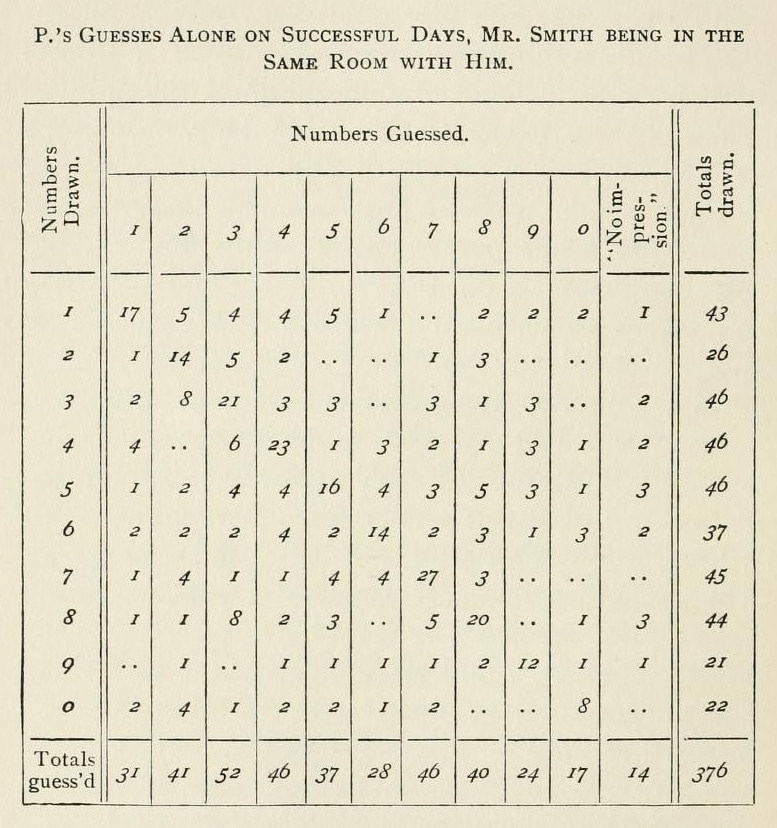
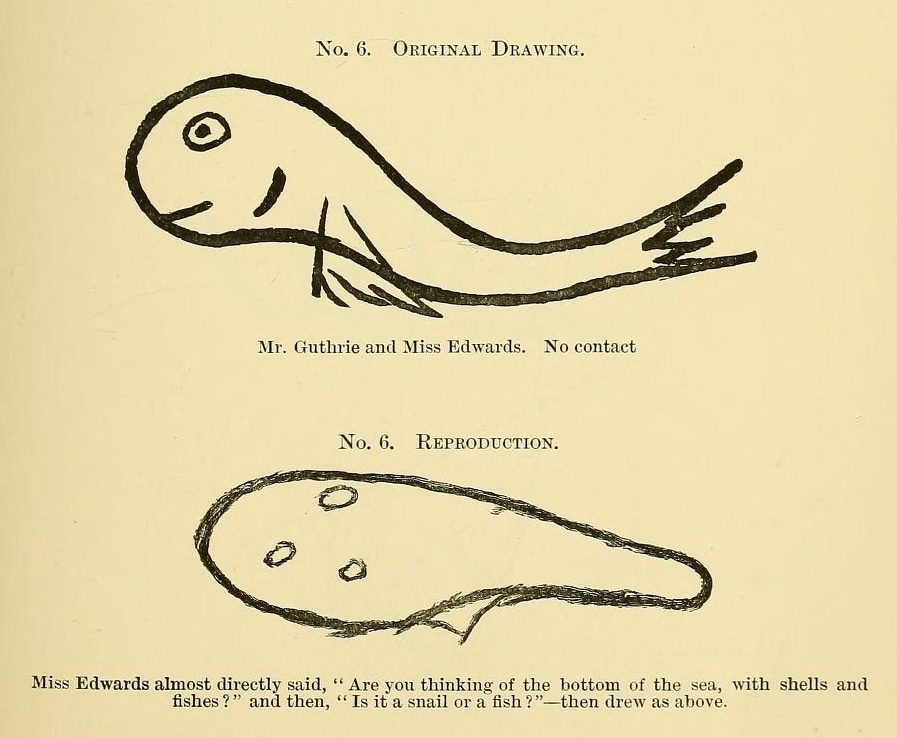
Barrett suspected that some psychical phenomena might be explained as the interventions of invisible, immaterial beings — not souls or ghosts, but natural, living creatures. In On the Threshold of the Unseen (1917) he wrote that “it is not a very incredible thing to suppose that in the luminiferous ether (or in some other unseen material medium) life of some kind exists”. He imagined such beings to be “human-like, but not really human, intelligences — good or bad daimonia they may be, elementals as some have called them”. But where, then, did they dwell?
One answer was proposed by the Irish physicist Edmund Edward Fournier d’Albe, who, like Barrett, taught in Dublin until moving in 1910 to the University of Birmingham in England. Fournier d’Albe was interested in electromagnetic phenomena and conducted experiments in radio and nascent television technology. He merged these interests with a belief in invisible beings and worlds with which we stood on the verge of making contact.
In Two New Worlds (1907), Fournier d’Albe argued that the recent discoveries in radioactivity and atomic structure implied the existence of an unseen spiritual universe continuous with ours. The material universe must now properly be regarded as an infinite series of worlds within worlds, which Fournier d’Albe considered to differ “only in the size of their elementary constituent particles.” He discussed two of them: the “infra-world” of atoms and electrons, and the “supra-world” of cosmic proportions. Both are, like our own world, teeming with purpose and life.
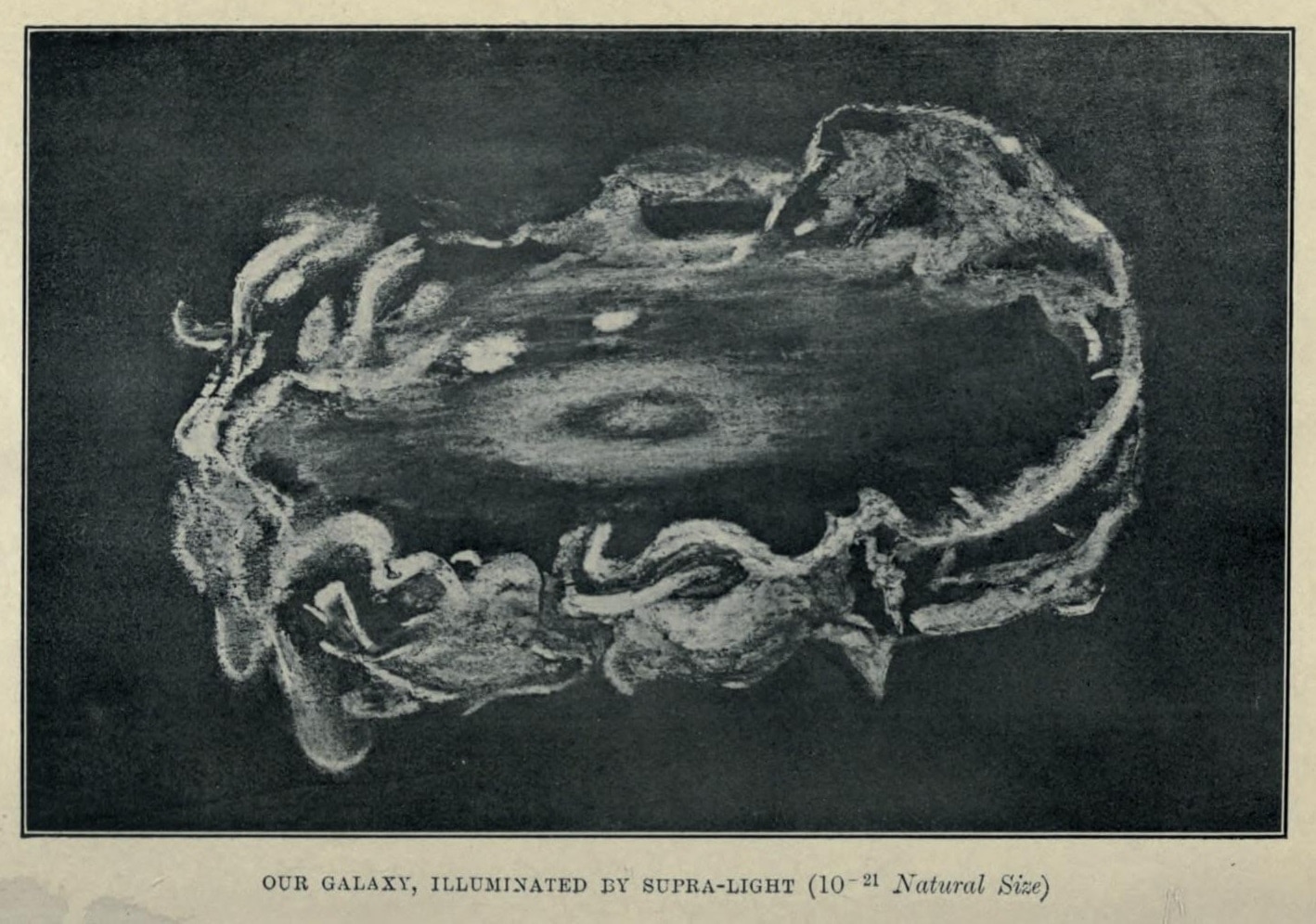
Fournier d’Albe expanded on these views in New Light on Immortality (1908), where he tried to come to terms with what the notion of a human soul could mean in the atomic age. To pronounce on immortality, he said, who now was better placed than the physicist, who understood the most about energy and matter? He supposed that what we call the soul might be a real substance, albeit more tenuous than vapour, composed of particles called “psychomeres” that possess a kind of intelligence and ability to act together via telepathic contact.
Fournier d’Albe claimed to deduce something of the nature of psychomeres, although in truth it was sheer guesswork. To estimate the number of psychomeres in a single human soul, he plucked a figure of ten trillion out of thin air. From this he calculated the mass of a soul as about fifty milligrams, and asserted that, were the soul-matter of a person to be condensed into a body just six inches high, it would have the same density as air and would float freely in it. Such a concentration of psychomeres might border on visibility: it could resemble a will-o’-the-wisp. “And thus it comes about that all the fairies, pixies, sylphs, and gnomes fly before the flaring light of science”, Fournier d’Albe proclaimed triumphantly. “They are not so much sent away as explained away”.
If, once this soul has left the mortal body, its “earth memories… should be awakened, and become dominant”, then it might gather again into its remembered earth-form: “first, a fine mist, then a cloud, a tall pillar of filmy vapour, from which a complete form, moulded and clothed to suit the character assumed, would then emerge, to walk the earth as before for a little while”. In other words, it would be what we have traditionally called a ghost.
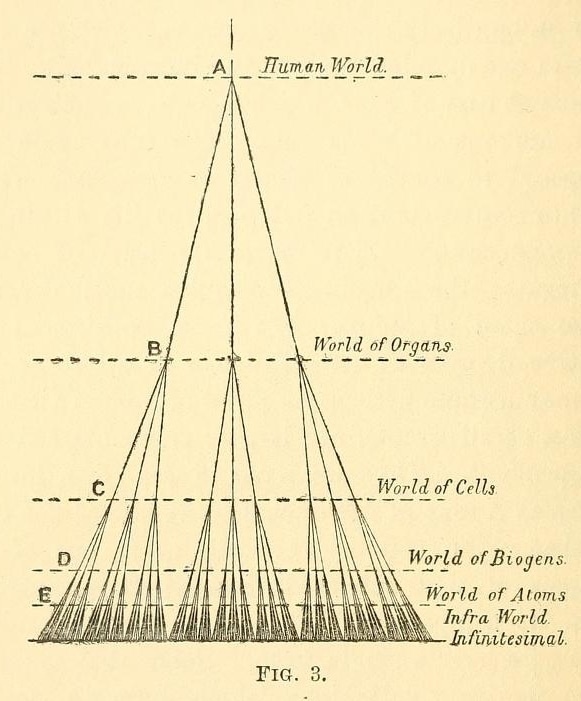
There was not a shred of real scientific evidence in support of these wild speculations. But wasn’t Fournier d’Albe in the end doing no more than what science has always done: to reduce complex, puzzling phenomena to a minimal set of propositions that could rationalize them? Besides, the invisible world that Fournier d’Albe was invoking could offer consolation for the increasingly barren picture of the world that modern science seemed to insist on. From natural history, he wrote,
theology has been ruthlessly evicted. The visible world being henceforth closed to it, it has taken refuge in the invisible world, where it feels free to make what declarations it likes. And that invisible world continues to be the ‘home’ towards which the weary heart turns from a world that has become indeed clean and bright and sanitary, but utterly hopeless and empty, if not unjust and cruel.
The idea that there might be an entire immaterial yet populous realm of existence was emboldened by the new discoveries of the late nineteenth century, particularly the mysterious X-rays first described in 1895 (and invoked by H. G. Wells in The Invisible Man two years later). Although these speculations might seem now to be an extraordinarily elaborate way to “explain” questionable events reported at séances and attested to by mystics like the theosophists, we should remember that the Christian faith already supposed such things. If some nineteenth-century scientists, such as Tyndall and Thomas Henry Huxley, started to question them, most people considered them unexceptional. As a scientific understanding of the world advanced, some scientists still felt a need to reserve a space for God, the soul, and the afterlife. No telescope or microscope was going to locate these things; they would have to be invisible.
Perhaps the most notable and thorough effort to provide a scientifically plausible account of invisible spirit worlds within a Christian context was made by the distinguished Scottish physicists Balfour Stewart and Peter Guthrie Tait in their book The Unseen Universe (1875). Although Stewart became president of the Society for Psychical Research during the 1880s, both men were sceptics of spiritualism, seeing in it nothing more than evidence of human suggestibility. Tait attacked spiritualists at the British Association meeting of 1871, bracketing them alongside “Circle-squarers, Perpetual-motionists [and] Believers that the earth is flat”. Yet he and Stewart were eager to understand how the “invisible order of things” that the Bible seemed to demand — the existence of immortal souls — might be consistent with the laws of physics. They aimed to refute Tyndall’s attack on religion in his address to the British Association in Belfast in 1874, in which he asserted that religion should not be permitted to “intrude on the region of knowledge, over which it holds no command”. On the contrary, Stewart and Tait insisted, science and religion were fully compatible. Yet their version of Christianity, on the evidence of The Unseen Universe, was starkly materialistic: they fit within a long tradition of both advocates and opponents of religion who insist on making it a set of beliefs about the physical world that may either be rationalized or disproved.
“We are forced to believe that there is something beyond that which is visible”, they wrote: “an invisible order of things, which will remain and possess energy when the present system has passed away”. This unseen realm need not be remote, but is present right alongside us — within reach, if only there were anything to touch. Its fabric might lie at the extreme of the gradual dematerialization of substance we already see in the physical world, where solid, liquid, and vapour were deemed to be followed by the “semi-material” existences of electricity, magnetism, heat, light, and gravity.
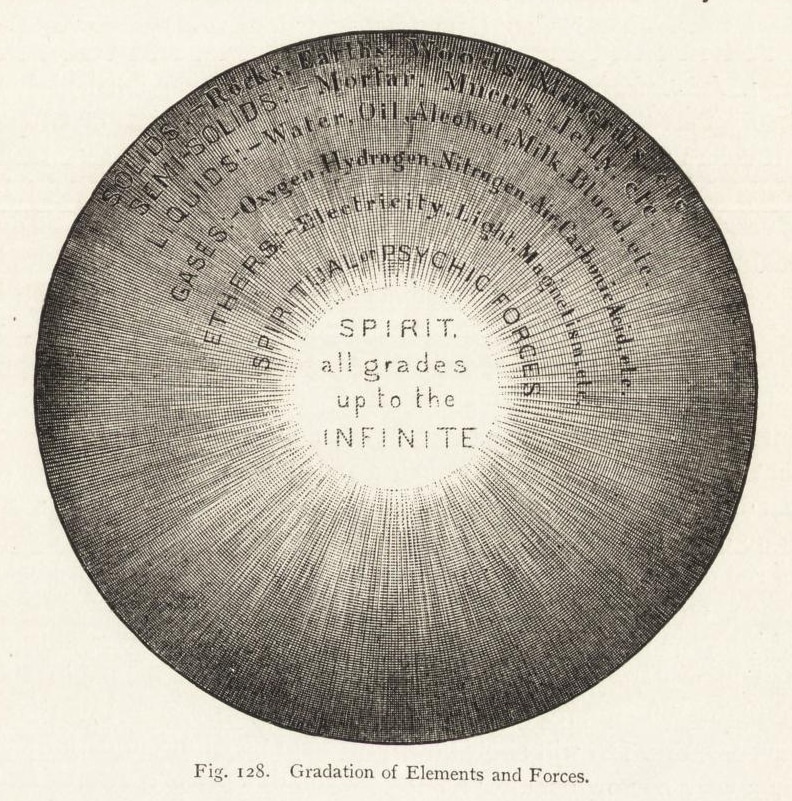
Life itself, Stewart and Tait argued, is a “peculiarity of structure which is handed over… from the invisible to the visible”. This transfer relies on interaction between the two realms: something enabled by the rainbow bridge of nineteenth-century physics, the ether. This ether-mediated communication is vital to the authors’ theory of the immortality of the human soul. We each possess a spiritual body in this invisible world, they said, which becomes energized by our actions and impulses in the tangible world. “Certain molecular motions and displacement in the brain” are in part “communicated to the spiritual or invisible body, and are there stored up” as a kind of latent memory. This accumulated energy makes the spiritual body “free to exercise its functions” even after bodily death. By living, we store up immortality.
There was, however, a problem. In 1850 the German physicist Rudolf Clausius formulated the first and second laws of thermodynamics: the conservation of energy and the irreversibility of heat flow from hot to cold. A year later William Thomson (later Lord Kelvin) pointed out that such a flow of heat inevitably dissipates energy, which flows into random motions of molecules and can never be recovered. This process, he said, must eventually create a universe of uniform temperature, from which no useful work can be extracted, and in which nothing really happens. But how can this “heat death” of the universe be consistent with immortal souls?
Here Stewart and Tait fell back on an idea proposed by their mutual friend, the Scottish physicist James Clerk Maxwell, who worried about the implications of the inexorable second law of thermodynamics for human free will. Maxwell’s solution was first articulated in a letter to Tait in 1867. What if, he said, there exist invisibly small beings — later dubbed “demons” by Thomson — that could cheat the second law by identifying “hot” atoms and separating them from “cold” in a random mixture, creating a reservoir of heat that could be tapped to do work? Such beings, Stewart and Tait now proclaimed, might “restore energy in the present universe without spending work”. It isn’t clear that Maxwell ever intended his demons to be more than hypothetical. But for Stewart and Tait they were essential agents of eternal life.
The unseen universe could account for almost any article of faith. “The scientific difficulty with regard to miracles will, we think, entirely disappear, if our view of the invisible universe be accepted”, Stewart and Tait claimed. “Christ, if He came to us from the invisible world, could hardly (with reverence be it spoken) have done so without some peculiar sort of communication being established between the two worlds”.
This, then, is where invisible forces and rays pointed for some scientists in the late nineteenth century: towards what we might regard as a thermodynamic theory of God, Christ, the afterlife, miracles, and an eternal Hell. Perhaps concerned about how far they had gone, Stewart and Tait published their book anonymously.
Physics has never looked back from this dematerialization of the world that began a century and a half ago. The speculations of Barrett, Fournier d’Albe, Stewart and Tait, and others (such as the prominent English scientists William Crookes and Oliver Lodge) were proposals that our visible world is not the only reality. That is just what physicists still assert today with their notions of the multiverse, 11-dimensional string theory, extra dimensions (“brane worlds”), and quantum-mechanical “many worlds” where parallel versions of ourselves go about their business. Contemporary metaphors such as a “hidden reality” (see physicist Brian Greene’s popular book The Hidden Reality [2011]) recommend themselves precisely because they have a history. Can there be any doubt that spiritualists would have delighted in “dark matter” and “dark energy”, these unseen particles and forces that supposedly dwarf the meagre quantities of visible matter in the universe and propel it on a trajectory that opposes gravity? When, in describing such concepts, cosmologists speak of “unraveling the mysteries of the invisible universe”, they are unwittingly invoking a long legacy.
History teaches us that attempts to patch over gaps in understanding by inventing invisible phenomena are both useful (they prevent science from stalling in the face of mysteries) and usually wrong. The echoes between contemporary fundamental physics and cosmology and the late-nineteenth-century visions of unseen worlds — extra dimensions, invisible intelligences, matter as knots of pure energy, atomized constituents of immeasurably small extent — should alert us to the territory we are entering, in which traditional tropes are informing the pictures we create. They are a reminder that science is constantly resurrecting old dreams in new guises. It seems inevitable that some of the current ideas about the “hidden universe” will one day appear as quaint and archaic as Fournier d’Albe’s soul-particles or Stewart and Tait’s thermodynamic immortal soul. If our descendants are fair-minded, they won’t laugh at that, but will recognize the well from which such ideas were drawn.
Philip Ball is a freelance science writer. He worked previously at Nature for over twenty years, first as an editor for physical sciences and then as a Consultant Editor. His writings on science for the popular press have covered topical issues ranging from cosmology to the future of molecular biology. His most recent book is Invisible: The Dangerous Allure of the Unseen (University of Chicago Press, 2015).
Public Domain Works
Further Reading

Invisible: The Dangerous Allure of the Unseen (University Of Chicago Press, 2015) by Philp Ball
In this comprehensive history of our fascination with the unseen, Ball shows how our simultaneous desire for and suspicion of the invisible has fueled invention and the imagination for centuries.
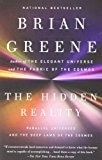
The Hidden Reality: Parallel Universes and the Deep Laws of the Cosmos (Vintage, 2011) by Brian Greene
The bestselling author of The Fabric of the Cosmos and The Elegant Universe explores perhaps the most mind-bending question in modern physics and cosmology: Is our universe the only one? A fascinating tour through a world more vast and curious than anything we could have imagined.
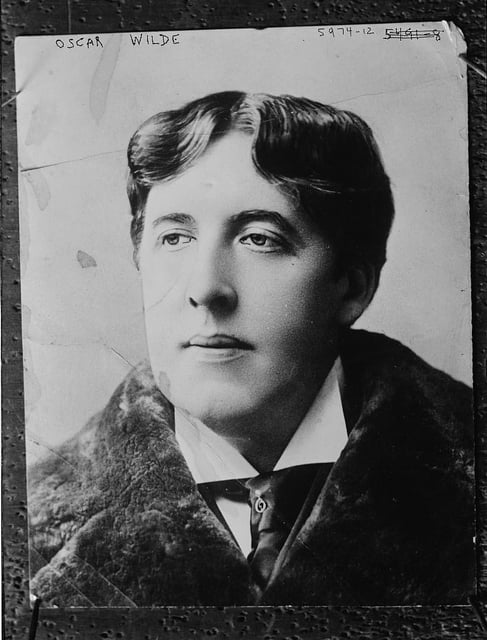 On Oscar Wilde and Plagiarism
On Oscar Wilde and Plagiarism